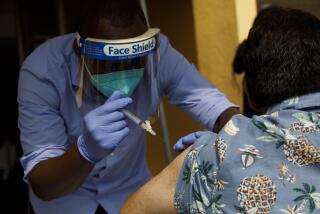State Gets More Vaccine
- Share via
The first new batch of flu vaccine arrived in California on Friday, weeks ahead of schedule and amid early signs that this season’s flu strain could prove more manageable than originally believed.
The federal government provided the state with 271,740 doses of the vaccine.
Although it was a fraction of the amount needed to handle the millions of people at high risk of complications from the illness, the delivery was one of two pieces of good news for medical officials.
The other came from new data, still preliminary, suggesting that people who get flu shots should be well protected from this year’s strain and that those who got the flu last year may be better able to ward it off this season.
Officials base the assumptions on early cases of the flu in the Northeastern states, which suggest that the strain, known as A Fujian, is affected by this year’s vaccine. The same strain hit last season, so people who got sick then may have a measure of protection.
“If you were exposed to A Fujian last year and it happens to be the dominant strain this year, you may have some immunity,” said Christine Pearson, a spokeswoman for the U.S. Centers for Disease Control and Prevention.
Flu vaccines in the past have not always been effective because they didn’t combat the flu strain spreading in a particular year.
There have been too few cases of the flu in California to determine what to expect from the flu season, which can peak any time between December and March. Pearson warned that it was still too early to know with certainty that A Fujian would be the most common flu strain in the coming months.
The nation’s supply was cut in half after British regulators suspended the license of a pharmaceutical plant in Liverpool because of manufacturing problems and possible contamination. The plant, which makes the flu vaccine for Chiron Corp. of Emeryville, Calif., had been expected to produce 46 million doses for the U.S. market.
The federal government intends to distribute the remaining 22.4 million doses of vaccine it secured from the other major vaccine manufacturer, French-based Aventis Pasteur, to public health officials in the hopes that they will get it into the hands of those who most need the shots.
Of the 271,740 doses distributed to California, Los Angeles County will receive 60,060. Orange County will get 24,760, Riverside County will get 11,950, San Bernardino County will get 13,090 and Ventura County will get 6,290.
The distribution was based on the high-risk population -- including senior citizens, young children, pregnant women and people with compromised immune systems -- in each county and on an analysis of past need for the flu vaccine. The Orange County Health Care Agency, which will receive vaccine from the state Thursday, is developing plans to distribute it. Part of the problem, said agency spokeswoman Pat Markley, is that any facility that gives out the vaccine would be inundated with people.
Fred Richman, CEO of the Coalition of Orange County Community Clinics, said the health care agency had contacted the group about distributing the vaccine through its 31 clinics. But even if it distributes the new batch of vaccine, the county health care agency would have less than half of the 58,000 doses it ordered.
Some private health care facilities, such as skilled nursing homes, are also receiving vaccines from suppliers, Markley said.
Kaiser Permanente in Orange County received 15,000 doses Friday from Aventis, in addition to the 30,000 it already had. But that was well below the 75,000 it had ordered, said Annie Mansell, senior project manager for primary care.
Kaiser, having vaccinated 27,000 people, was close to running out before receiving the new supply.
When Kaiser began inoculating its members last Saturday, the first patient at its Anaheim hospital lined up at midnight, Mansell said. By 7 a.m., all three Kaiser facilities holding flu clinics had lines of at least 500 people, she said. Because of the crowds, the clinics opened an hour early.
Kaiser is continuing to vaccinate those in the high-risk group at daily flu clinics at its hospitals and clinics.
UCI Medical Center is in one of the most unusual situations: It received all of the vaccine it requested from Aventis. “We have enough for UCI patients and health care workers who have requested them,” said Kim Pine, a UCI spokeswoman.
It remains unclear when or how many more of the 22.4 million doses available nationwide will come to California.
Laurene Mascola, chief of the acute communicable disease control program for the L.A. County Department of Health Services, said there is plenty of time for people to be vaccinated.
Officials do not know how many high-risk patients have received vaccinations, but more are expected to seek the shot this year because of media coverage of the shortage.
Even if more vaccine arrives in the coming weeks, it won’t be enough to cover all high-risk patients.
Public health departments across Southern California usually provide the flu vaccine only to people who cannot afford to pay for the shots. Most people get the vaccine from hospitals, clinics, retailers and doctors’ offices.
Although health agencies have received little or no vaccine this year, some private health providers got shipments and have been providing the shots.
But officials are urging that people not in the high-risk category forgo the vaccine this year.
Health departments suggested that people consider using antiviral medicines or the nasal inhalant FluMist if they can’t get vaccinated. However, Kaiser and the Orange County Health Care Agency have been unsuccessful in buying FluMist, which is approved for healthy people ages 5 to 49.
The most effective preventive step, they say, is good hygiene: People should wash their hands frequently, refrain from touching their noses and mouths and stay home if they are ill.







